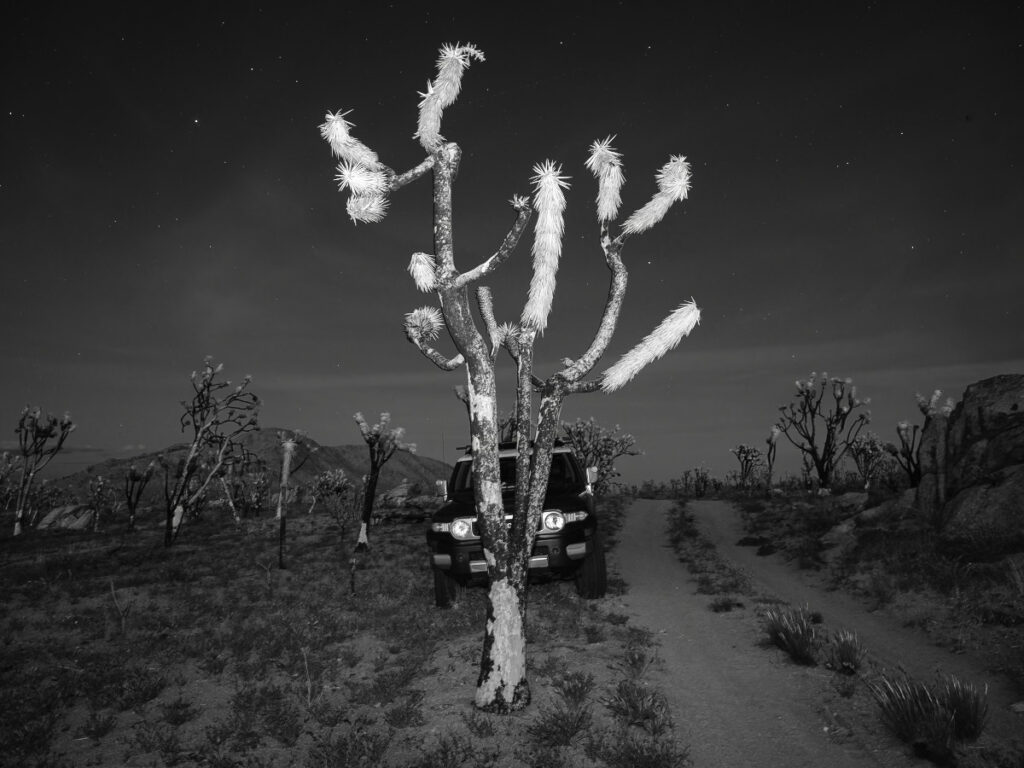Going off-road
The most difficult thing for me about choosing which van to buy was the question of off-roading. This is a big deal in van-world. People spend $150,000, $170,000 and more on vans that are “off-road capable” and then, in many cases, they will spend tens of thousands more on “mods” for the van. New tires, new suspension, aluminum storage boxes hung from the rear, rows of lights on the front up high, rows of lights on the front down low, huge, ungainly-looking bumpers, blacked-out hoods, blacked out windows, antennas and sorts of electronic gear, and maybe even a snorkel high on the right to suck in clean air above the fog of dust kicked up on the off-road by the van in front of you.
The vans look like war machines, about to enter battle. And I think that look, that tactical badass look, is half the point, if not defining the purpose itself.
Don’t get me wrong. Getting to places that are hard to get to is important to me. In 2019 I was the “artist-in-residence” at the Mojave National Preserve where there are few paved roads and fewer established hiking trails. It’s an exploration park, to use a phrase favored by one of the rangers, and I spent a month there, exploring it indeed. I drive a Toyota FJ Cruiser, which seems to be able to go anywhere, and I went everywhere. Big rocks in the road? No problem? Road washed out? No problem. A tree fallen, blocking the sand track through the desert? Just go around.

No van, no matter how modded, could go everywhere the FJ could go, and I knew that. I just wanted, or thought I wanted, a van that could do all but the very worst trails, all but the most difficult paths.
At the same time, I wanted a van that would comfortably carry two people—a challenge in such a small space—where we could both relax and work and enjoy ourselves. Those two ideas, it took me a long time to realize, were in opposition to each other. I wanted a comfortable table in back, the van makers were making vans with garages—open areas to store your dirt bike and other gear. I wanted a van with lots of big windows. Van makers were making vans that were “stealthy”—that looked like regular old vans with smaller windows or no windows at all, so that they could park on neighborhood streets without the cops knocking on your window at midnight (known amongst van enthusiasts as “the knock”), or park in your driveway without the HOA biddies freaking out.
The decision path we took was a long one, going from Airstream trailers, to vans, back to trailers, back to vans, flirting with a truck insert, thinking maybe the whole idea was a dumb one, then back to vans again. At the end there were two main contenders. The Tiffin GH1, very similar to the better-known Winnebago Revel, and the Noovo Plus. We were stuck there for a long while, the Tiffin offering more of the off-road possibilities, the Noovo offering a better work-life balance, so to speak, but little in the way of off-road ability. There was no clear direction, no obvious winner.
And then I realized three things:
- I already had an FJ Cruiser that could go off-road, more off-road than the GH1.
- As we live in California, all of the places I might want to go off-road were in the American West, not that far way.
- If I planned a trip that required off-road driving, I could take the FJ. If I planned any other sort of trip, I could take the Noovo. I could have the best of both worlds, I could have it all.
This all sounds so simple and obvious, and maybe it is. But it took me a long time to conceptualize it in this way.
The lesson? There is no perfect van, no perfect anything. But by understanding your needs—and recognizing which of those needs have already been met—you can create a mix of capabilities that gets a whole lot closer to perfection.
